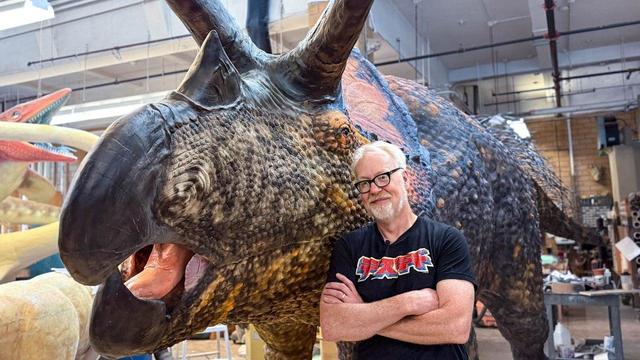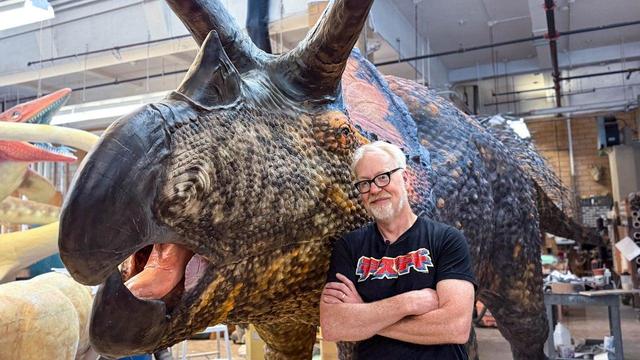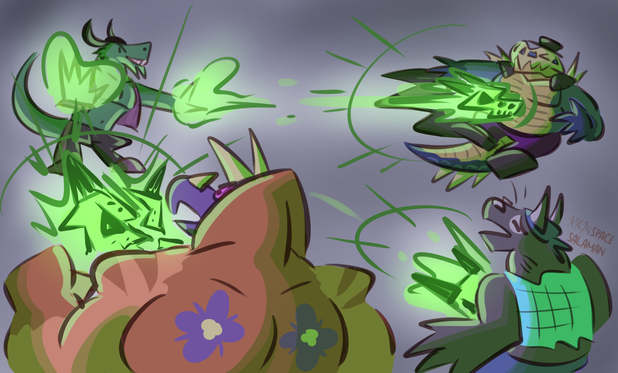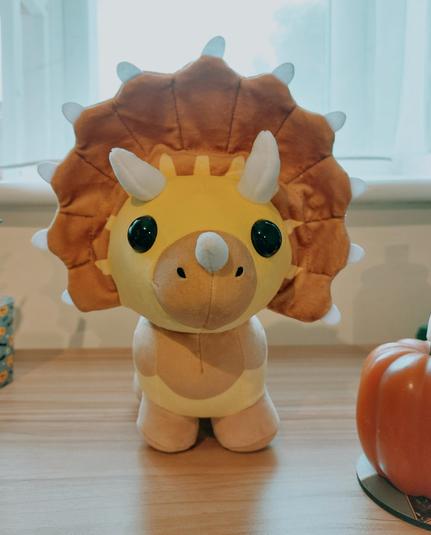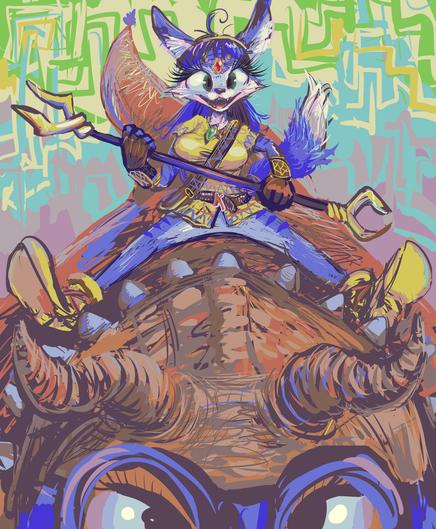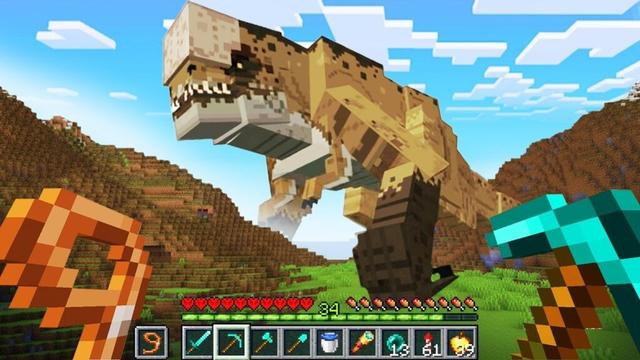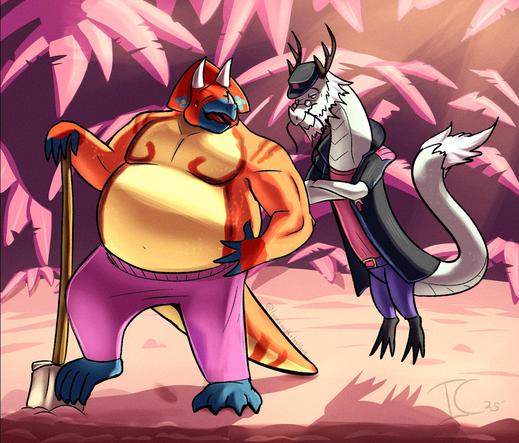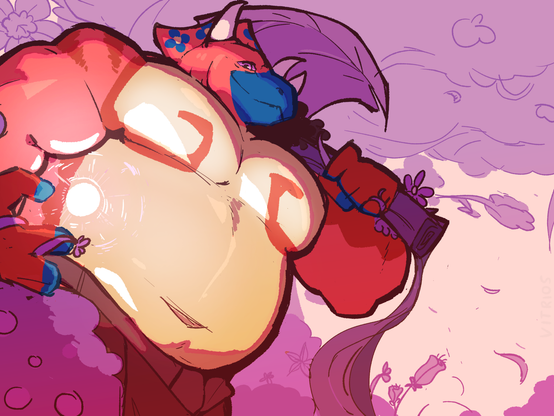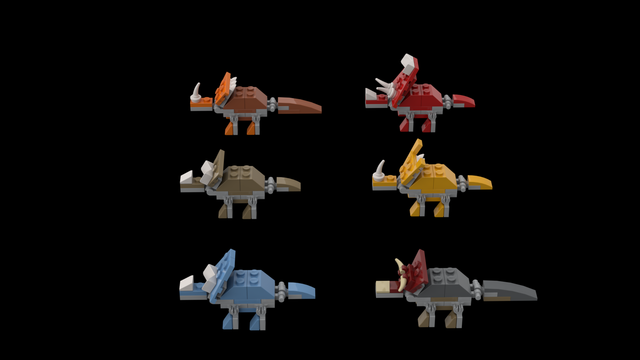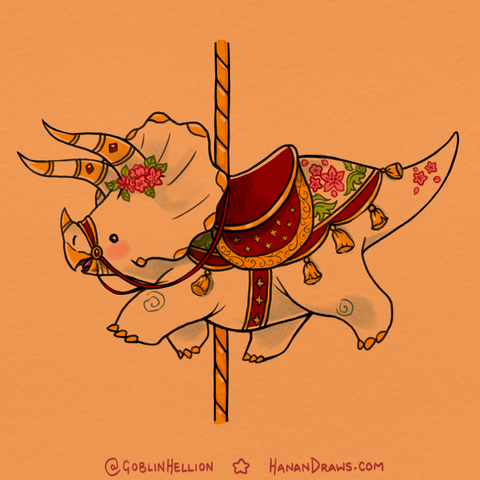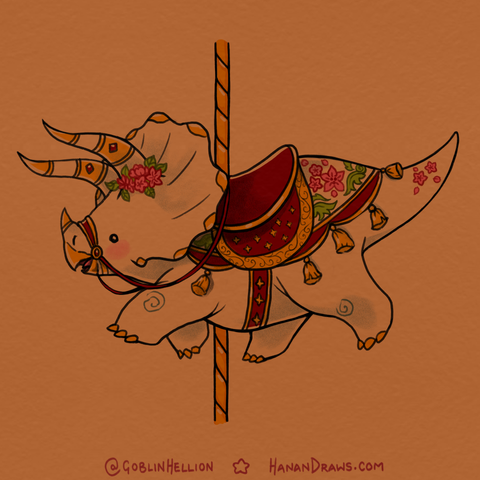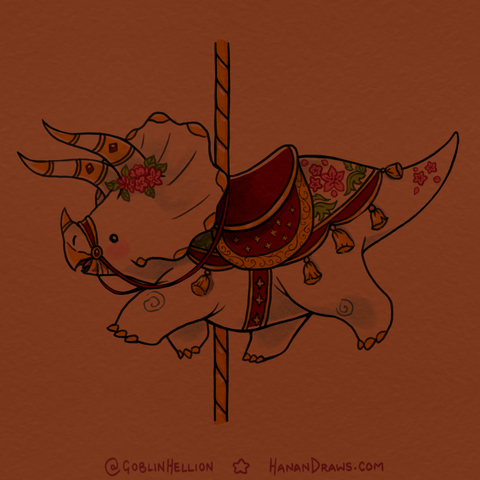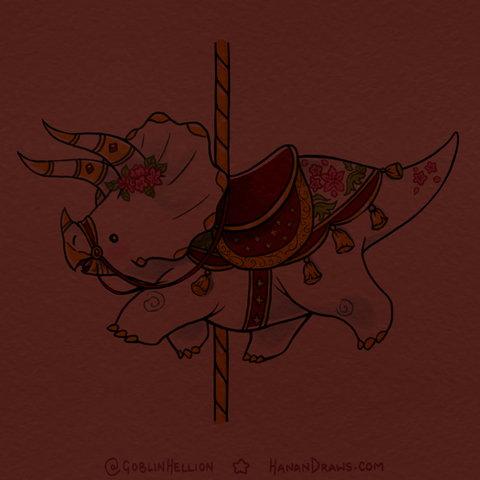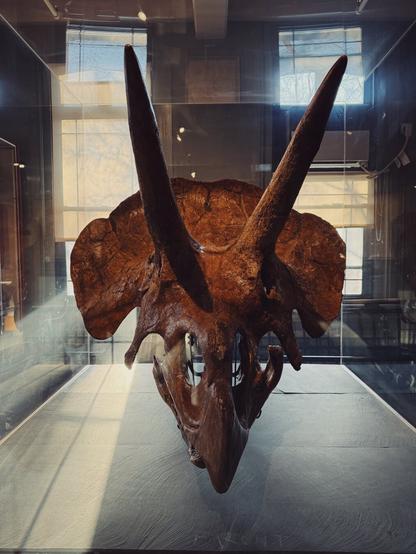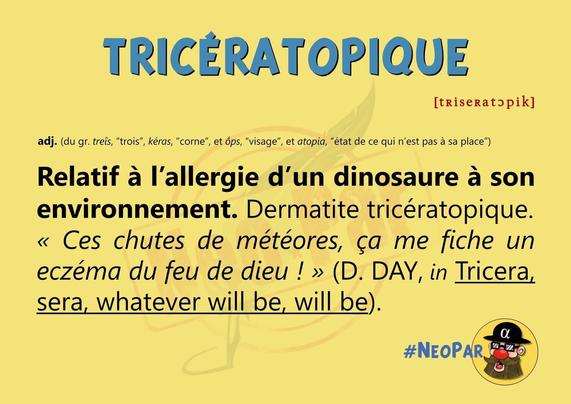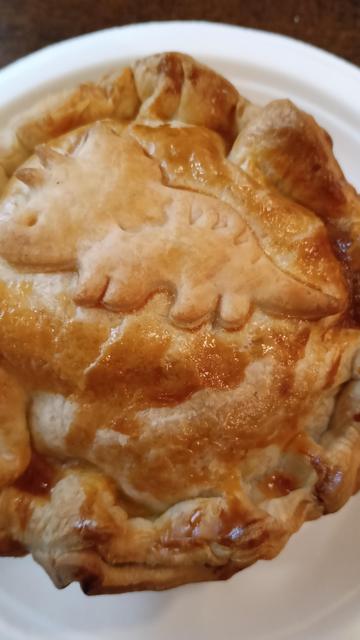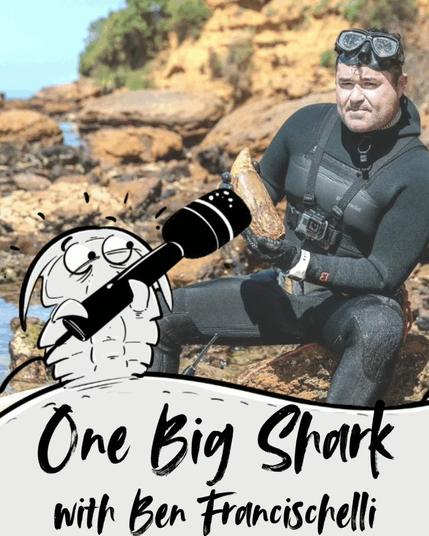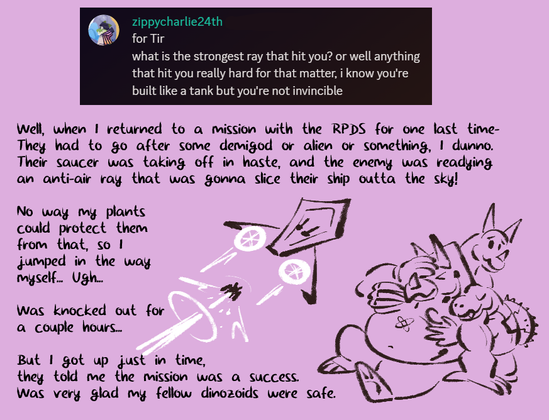Transcript: Episode 49: One Big Shark
This is a transcript of Episode 49: One Big Shark.
Fossils and Fiction (00:00)
Sharks are the coolest. Let’s face it. Everyone froths on sharks
Travis Holland (00:27)
Welcome to a new episode of Fossils and Fiction. We have a wonderful paper to talk about this episode, the dinosaur dance floor, as well as a fantastic interview And a nice fun segment of would you rather coming up as well, but let’s start with the news on that paper. So this one has been promoted by one of the authors, Sally Hurst, a former guest on the podcast as a dinosaur dance floor.
Alyssa Fjeld (00:39)
You
Travis Holland (00:53)
It’s a pretty exciting piece of research which shows a series of tracks in a new track site from Dinosaur Park formation in Alberta, Canada. What did you make of this paper?
Alyssa Fjeld (01:06)
Well, I think it’s really exciting anytime we see new research coming out of Phil Bell’s lab. Phil Bell is a professor of, I believe, vertebrate paleontology at the University of New England in Armidale, where I spent half my time. Phil is an absolutely lovely person. And actually, funnily enough, the first person I ever interviewed for a podcast, it was an unpublished school project for my master’s. So I’ve known Phil for quite a while.
Travis Holland (01:16)
Mm-hmm.
Alyssa Fjeld (01:30)
I think his research, especially in regards to the dinosaurs we find here in Australia is really interesting. So Phil Bell is somebody who’s worked for a long time with the Lightning Ridge Mine up in New South Wales, which is a mine where we also find a lot of opalized dinosaur bones. And Phil has also got some really great connections up in Alberta. He’s actually, believe, there right now or has just come back with some of the UNE students. And at the dig site that we’re talking about in this formation,
They’ve made this incredibly rare discovery. if you think about the way that we normally present dinosaur tracks and dinosaur trackways, one thing that you may have seen by other science communicators is that the really important part is having a series of steps because that’s how we measure things like gait. And when you see these multi-taxic
dinosaur footprint assemblages, that means that you’re getting all of these animals of various sizes operating in different areas of the ecosystem, all running around at the same time. Not unlike a middle school prom dance.
Travis Holland (02:28)
A middle school prom dance for ceratopsians. So yeah, the paper’s really cool. It’s got some wonderful graphics and images as well. It’s the Skyline track site. They’ve called it Dinosaur Provincial Park in Canada. And as you say, multi-taxic. it’s a track site that includes footprints from multiple different types of dinosaurs, including ceratopsians. They’re the most prominent. Two tyrannosaurs.
So it’s about 75 million years old and the tracks I gather from the paper are pretty rare actually in this part of the world. So there’s only ever been one hadrosaur and some tyrannosaur tracks found previously in dinosaur provincial park. But here there is a bunch of, as I said, ceratopsian prints. So multiple parallel,
footprints with a regular arrangement. This suggests gregarious or herding behavior. They believe there were some, at least five ceratopsians there traveling together towards the water. And I found really interestingly, it’s almost like a throwaway line towards the end of the paper that although they had named a couple of likely species and said it was probably Styracosaurus Albertensis or a Chasmosaurus species, that if you accept the gregarious nature of the tracks, the likelihood that it was herding
that means it’s probably Styracosaurus because they are more, there’s evidence, there’s other evidence of Styracosaurus herding, but not chasmosaurs. So that’s their assumption is if you accept that this is herding behavior, then it’s probably was the Styracosaurus. So I love that you could put all those lines of evidence together and say, we have a herd of five ceratopsians, probably Styracosaurus here in the same location. And then on top of that, two tyrannosaurs.
Alyssa Fjeld (04:00)
I like.
Travis Holland (04:12)
which are probably Daspletosaurus or Gorgosaurus and also probably two individuals walking together. So cool.
Alyssa Fjeld (04:19)
really, really precious stuff. And I really love that vertebrate paleontologists, when they’re looking at these trackways, use the term gregarious as well. I learned that that was a word used to describe behavior in the fossil record this year by stumbling face-first into it with a group of paleontologists because it sounded really silly to me. I wouldn’t think that gregarious would be…
the first term that comes to mind when you’re describing interactions at this scale, but I love that it is. I love that it kind of sounds like your friend Greg is at this dinosaur dance party with all of these tyrannosaurs taking their evening strolls. Yeah, and one of the interesting things to note here as well is that, you know, with these other trackways that they found in the past, hadrosaurs, tyrannosaurs, these are heavy animals.
And when we’re talking about trackways, we’re talking about animals that are heavy enough to press down into the substrate to leave the footprint. In order to capture the smaller footprints of some of the species that they’re seeing, a lot of other things would need to go very well. You would need the right kind of substrate, the right kind of conditions to get those fossils. So it’s a super lucky find in so many ways. Congrats to the team.
Travis Holland (05:21)
Yeah, absolutely. Super fascinating. And certainly, I say, Sally Hurst has been out there on her socials on the Found a Fossil site and her own Instagram posting videos about the discovery as well. So it’s worth checking out that paper and we’ll have a link in the show notes.
Alyssa Fjeld (05:39)
out Sally’s communication. She’s really good at this stuff.
Travis Holland (05:41)
Sally’s great. Lots of fun. Another bit of exciting news. Apple TV Plus has announced a new season of Prehistoric Planet and we are going to the Ice Age.
Alyssa Fjeld (05:53)
I couldn’t be more excited. I see those big toothed cats and I can feel nothing but joy in my heart. How exciting is this?
Travis Holland (06:01)
It’s so good. And it’s coming this year. I I love when you get an announcement of something and it’s like, it’s only a couple of months away. It’s coming now instead of one of these films that’s like, you’ve got three years to wait till this comes out,
Alyssa Fjeld (06:14)
And I really like that they’re tackling some of the funkier animals from this period in Earth’s history as well. Like we’ve gotten hints of a glyptodon, which is a really fun animal. And I think it bodes well for the maybe, hopefully, including some of Australia’s own very strange megafauna. Like I would love to see a zygomaturus
Travis Holland (06:33)
yes. zygomaturus or of course, Thylacoleo, the marsupial lion as it’s been called. Yeah. We would, that would be so good. And our own lumbering giants, the Diprotodon as well. That would be really fantastic. But I, I’m pretty excited to see the Glyptodon. I don’t, there’s not been very much paleo media that has given realistic depictions of Glyptodon. So these are in my understanding, I’m probably totally wrong. I think xenarthrans
Alyssa Fjeld (06:37)
definitely.
Yeah.
Travis Holland (07:01)
They’re armadillos or close to armadillos. Armadillos are xenarthrans. Maybe these guys are xenarthrans but basically they’re huge, right? They’re the size of BW Beetle with these sort of tanks on their backs that look like big shells, like armadillo shells. yeah, they’re massive armadillos wandering around the old West.
Alyssa Fjeld (07:03)
Yeah. Yeah. Yeah. Yeah.
It’s so
cool, like they are shaped so round. I love how tremendously round they are, like turtles have never been so brave.
Travis Holland (07:25)
Mm.
They remind me of the aliens at the start of the Fifth Element
Alyssa Fjeld (07:33)
See ya!
Travis Holland (07:34)
And I suddenly made that connection. was like, wait, these, these look like, these look like glyptodonts. The aliens look like glyptodonts or the glyptodonts look like the aliens. don’t know. Who knows?
Alyssa Fjeld (07:44)
And speaking of megafauna, we’ve got a really exciting interview coming up with you guys today for some of the large beasts that dwell beneath the ancient seas of Melbourne. We will be talking to our very own good friend. Well, I don’t know if we’re friends, but he puts up with me. Ben Franchischelli is a researcher who completed his PhD looking at some of the largest predatory sharks ever live, if not the largest predatory sharks ever live, the megalodon.
And we have a nice little chat about some of the megalodon and other shark species that are found in and around coastal Victoria at a location called Beaumaris in particular. So if you’re really interested in hearing some fun banter from me and Ben, check out our interview coming up now.
Fossils and Fiction (08:24)
Today we have Ben Francischelli with us, an expert on the Bayside fossils that are found at the Beaumaris fossil location. Hello, Ben. Hello, thank you for having me. I’m very excited to talk about that and other very gigantic predators today. Absolutely. So for those of us who are not in Australia,
Ben works with a diverse location in the miocene Is it myosin? It is myosin. It’s kind of like right on the apex of the miocene-pliocene right there. So that’s a really interesting junction. It’s a…
shallow marine shelf environment that is populated by a variety of interesting creatures. We’ve got, you know, pelagornithids, the false-toothed bird. Terrifying. Terrifying stuff. We do not like birds with teeth. No. Not a fan. I mean, if you could imagine them in your dreams, they’d be haunting you for sure. They’d be nightmares, really. Yeah. And then there are some interesting little basal whale creatures. There are some dolphinoid type of things. Yeah, there’s some weird looking dolphins that look like the modern La Plata River
dolphin as well. They’re only getting to about two meters in length. These really nimble little teeth running all the way down their jaws, but they’re very strange to look at. We’ve got some strange creatures. We’ve got some large creatures, but obviously here at Shark Week we care the most about our sharky friends. Sharks are the coolest. Let’s face it. Everyone froths on sharks and understandably so. They’ve been on the planet for like 400 million years, so what’s not to love? They’ve seen several North stars and there are no competing giant ocean creature people here to contrast what you’re saying.
I mean, it’s really a toss up between two. And if you don’t think this, you’re basically wrong. But sharks and whales, they are just the most incredible animals that have ever lived on the planet. Their evolution, the way they’ve subsisted on the planet for as long as they have, they’re just incredible. So what’s the coolest thing about sharks that you can tell us in their evolutionary history? goodness. Probably one of the coolest thing about sharks is probably the length of time that they have been on the planet. I think the estimate is anywhere between 420
20
and 440 million years. I mean, the common thing that’s often said about them is they’re older than trees. And it’s true, they really are. They have survived in a basic form throughout that entire period of Earth’s history, survived all these mass extinctions as well, which took out all these other huge reptiles and other mammals as well and everything else, but they have been able to survive all the way through it no matter what.
And that’s compared to animals like sauropods or your giant nautiluses, your ichthyosaurs, etc. I mean that’s actually comparable to the age of the horseshoe crab, which is the meme at the moment.
Yeah, it just survives. Yeah, but the horseshoe crab is tiny I mean dwarf lantern sharks get to about the size of a ruler of about 25 to 30 centimeters in length They’re really cute and they may I think they might even have the bioluminescence Which is really cute because they’re found really deep in the sea But then of course you’ve got the opposite side of the spectrum and you’ve got the 12 meter long modern whale sharks Which are absolute chunky heckin big boys. yes. Yeah, and those are animals that you
can meet off the coast of Western Australia if you should ever choose to visit. Please choose to visit. We need your money. But some species of shark have actually been around an incredibly long time as well. I want to say it’s the species of shark, or the group of sharks that…
PJ’s, Port Jackson’s belong to has been around for absolutely. They have, I think you can even find very similar looking creatures going all the way back to the Cretaceous as well. And they’ve got remarkable looking teeth. They don’t look anything like a shark’s tooth. Cause when you think of a shark’s tooth, you think of a dagger like implement, a biological weapon honed in to slice me to some exaggeration. That’s what Jaws told me. Yeah, exactly. Just stay in the boat and you’ll be fine. But they look so cute. They’ve got this wee little pig like nose and they’ve got these tiny little
jellybean like teeth that are just perfectly adapted for crushing crabs and sea urchins and other things like that. And they only get to about two meters in length, but they are adorable. They’re absolutely precious. They’ve got a little mustache shaped smile and the only recorded bite on record was from Melbourne. That’s right. just latches on someone’s leg and it just didn’t let go. So funny. Yeah. And their eggs are also extraordinary as well because they’ve got that weird corkscrew like spiral and then the babies hatch out of them. And the mother
Others have been observed actually physically screwing the egg into rocky crevices and then swimming away. I mean, to be honest, that’s preferable to the human method. The human method has got to be the worst method by far. Even a blue whale and stuff like that, you’re like, yeah, it’s a big baby. But like the human one.
The cranium, the hips, that’s not math that maps. That’s the opposite of girl math. Well, there is the sand tiger shark, or the grey nurse as well, which practices intrauterine cannibalism. And for our listeners, can you explain what that is? Yeah, so there’s two wombs inside the shark, two uteruses I should say, and there’s six or seven pups within each of them, and they can actually swim in between them as well, which is really strange to think of.
kind of animate a little bit earlier than all the others and then just start eating all the other brothers and sisters inside of it but by the time it comes out the pup is about a meter in length perfectly adapted for the environment around it
That’s great. mean, imagine if we came out able to walk and talk and also eating all of our brothers and sisters. probably make things a bit easier to be honest with you. mythological shit. It really is, isn’t it? So, grey nurses, I believe, are one species that we still find in modern shark assemblages around Australia. Are they animals that we also find in the fossil assemblages where you’re focused? Yeah, and what’s really interesting about them as well is that…
we can find them dating back to about 30, 35 million years in the fossil record, or at least something that superficially looks like it. When it comes to shark teeth and the fossils of sharks that are left behind, we usually only have their teeth. And unfortunately for grey nurses, there are a number of species that have very similar looking teeth. So it’s like, it’s probably a grey nurse. It might be a grey nurse. It’s the best conjecture that we can kind of take from it, but we’re not entirely sure whether or not it absolutely is. And you wouldn’t expect it to be the same species surviving
for a 35 million year period all throughout the fossil history of Victoria as well. Probably one of the saddest things about it though is that it’s practically locally extinct in Victoria now. So we hunted them through to extinction. And I remember going down to Bowie and there was a bloke there in probably his 60s or 70s. And when he was younger, he was telling me about how he used to see them swimming around.
But how people would hunt them because they thought they were man-eaters and we simply did not think any more of it and just assumed that that was the case and yeah Every single one in Port Philip Bay was exterminated right I mean I think as part of shark week You know one of the topics that we’re interested in here at Fossils and Fiction is the differentiation between the way sharks are portrayed in the media and the way that sharks actually behave Yes, I think it’s like now common knowledge in pop media that the person who wrote jaws the book later came back and said well if we’d known nearly as much
about sharks. I would not have written the book.
There was a similar conception as well for dolphins and whales. People back in the 1950s, really had no idea what these animals were properly doing and at the time they were just hunted mercilessly. But when the studies started coming out about their intelligence, some of them have cultures as well. Like, you know, the orcas wearing the salmon hats and stuff. killing the billionaires. Really funny stuff. Yeah, Classic orcas. So good. Come on Elon Musk, have a yacht ride. Yeah, exactly. Just ram the boat. Do what Jaws would
basically be doing. we just underestimated the orcas is what it is. But it’s the same level of awareness that we need to get up to speed with and unfortunately Jaws has done a tremendous amount of damage to what we think of as sharks and the other unfortunate thing is that when you do look at a great white shark they are a terrifying looking animal to look at. Like there’s that kind of un…
conscious bias that we have as a mammal. You know, like we look at something like when you hear a lion roar, it really goes all the way down your spine. And I get a very similar feeling whenever I see a great white shark. I’m like, I need to get as far away from this animal as I possibly can. Stunning, beautiful, very important, ecologically important animal, but equally as terrifying. And that’s what makes it so cool. Exactly. Well, and then there are animals that have survived for so many millions of years, hundreds of millions of years, because why change what isn’t broke? Exactly.
And when we talk about apex predatory sharks and we talk about the concept of shark week I’m sure there is a lot of media out there hyping up the Megalodon as all sorts of things that it might not actually be so I’m curious to learn what the difference is between the fact and fiction on Megalodon. man, the first question, so I give a number of talks every single year about the Megalodon and the first question that’s often asked in the audience is like, it still alive today?
It’s like child, and sometimes they’re adults as well, and I’ll refer to them as the same thing. was like, if such a massive animal was still alive in the ocean, we would have absolutely no doubt that it would be there. We’d see the carcasses of whales washing up and show the giant bites out of them. We’d find their teeth because like all sharks, they have a conveyor belt of teeth that are constantly being lost and staggering.
Like there was one estimate for a type of requiem shark which was 30,000 teeth in a single lifetime. Jesus, that’s a lot of calcium. It’s a lot to deal with right there. So if they were there, we would absolutely know they haven’t hidden in the Mariana Trench or something really deep like the Jason Statham or anything like that. They are a hundred percent gone. And it also makes sense as well because at a certain point of the fossil record, we just simply put cannot find any more fossils of them at all. Yeah.
Exactly. And with Megalodon shedding that many teeth at that level of size, I think it would be pretty apparent if one had survived.
When do they go extinct? It is a really good question and I don’t think we have the full evidence available to us right now to really properly understand it. So at the moment there was a paper by Boessenecker that was released I think in 2019. Good old Boessenecker. Boessenecker. I’ve never met the guy before. I’d love to if you listen in Boessenecker, reach out to me. What a legend. Yes. I love the name and also he’s a whale fanatic like me. And he’s from my area. We’re southern friends. He knows what good fried chicken’s about. I assume.
But his paper! Boessenecker fan cam! Oh goodness. What was I saying again? Yeah, so his paper suggested that they probably went extinct at about 3.6 million years ago and were absolutely gone off the planet by about 3.2. Right.
It has a bit of an American bias to it and a Northern hemisphere bias to it as well. And there are a couple of sites, even in Australia as well, where we know Megalodon teeth are being found that are geologically younger. And I suspect that we just don’t have the data for them at all. And that’s one of the really big issues with paleontology as well. Everything is kind of kept a secret by all the other individual paleontologists trying to get the scoop on some really big news story and stuff, not willing to share it until they’ve already…
release the data for something like that. So the current estimate is 3.2. It was absolutely extinct, but I really have no doubt that it may actually be quite younger than that as well. That makes a lot of sense. I would assume that you also see the species that it’s preying upon have a very distinct relationship to the disappearance of this apex predator as And the absolute fabulous thing about the Megalodon is that like literally nothing was off the menu at all. you like, there’s a fantastic site of Peru.
Pisco basin and it’s turtles, seals, all manner of birds, like whales, probably other sharks as well. not that they’ve probably found much evidence of something like that and more would you expect the fossil evidence to be preserved showing that kind of relationship. But like you can see the distinct grooves where the blade of the tooth can fit perfectly in the bones. And in some cases as well, it looks quite obvious that some of the bones have actually healed over time with the group.
of teeth that are still embedded and then it’s healed afterwards. we know that this was certainly an active predator on marine
Yes, and it was doing some incredible things that we do not see today and this is an animal So for context for listeners at home, this is not an animal that would have been able to eat homo sapiens They had not probably evolved during the time frame. yeah. I mean you can imagine what was it? Homo florensis or erectus it was Australopithecus kind of looking off the cliff, you know One meter tall and just like booing and ah-ing to one another. Yeah, what that big fish? that big fish it ate my brother not that they would have been capable of talking But if they were that might have been what they said to each
You know, they only just came out of the trees basically. Yeah, they were pretty busy. They had other stuff on their minds. But this is an animal that has really distinct teeth if you think about like a steak knife. I would assume it’s a little bit similar. It is very similar to that. So the serrations on the blade of the tooth, the cutting edge are all very similar to one another and the steak knife is the perfect example to kind of compare it to. There is, so great whites have very similar dentition to them, but they have relatively irregular jagged margins to the margin of their teeth.
and what I think is really beautiful is that we have this evolutionary sequence for a period of about 50 million years, the ancestors of the megalodon, where we can see the serrations and the tooth starting to get bigger and bigger until it gets to its absolute larger size right at the end of its reign. Of course. And it’s like the bigger than the size of the palm. Some of them are seven inches, like, what is it, 18 centimeters? It’s huge. It’s an absolute monstrous animal that would have had, you
200 of these teeth in its mouth a mouth that was so large it could have just swallowed me whole very easily and Theoretically if it wanted to it could have probably taken down something the size of a blue whale by itself It’s insane it really there is just no like don’t get me wrong orcas are capable of taking down blue whales sure But they work in pods. Yeah, they’re systematic. They’re calling out to one another They’re trying to drown it from the top this thing with this humongous man
just would have been able to come up from the depths in a similar way if you could imagine a similar way that a great white would probably hunt take a bite of the fluke and just let the animal bleed out and then feast on the remains I’m thinking as well about the distinction in Jurassic Park the original one there are no other Jurassic there are no other ones I’m sorry Travis
Tune in for our interview with the Jurassic World producer. that’s going to be interesting, isn’t it? I didn’t say anything. The point is, I’m thinking about the scene with Robert Muldoon and the velociraptors versus the T. rex just eating the lawyer on the toilet, being megalodon here. And if you’re interested in seeing some more lovely shots of how big a meg-tooth could be, Ben has some photos of that on his Instagram with a palm-sized comparison. Ben’s hands are much larger than mine, so the shark would absolutely have been able to decimate probably anyone in this cafe.
Well that’s the thing, so we know that it was eating pretty much everything that was there. Would a human have interested at all? Exactly, I mean we’re kind of tendony. There’s lot of pointy bits. a of bones as well. But then again they’ve been observed biting into the carapaces of turtles and sea turtles. what’s in there for you, you know? Exactly. Is that the paella of the shark world? It’s pretty crap, really. Like, just spit it back out, honestly. So you mentioned the evolution of the megalodon and for our listeners at home who
may not be familiar, the genus name for Megalodon is a somewhat contentious topic. It’s terrible to talk about, isn’t it? Yes. You don’t have to comment, but do you have opinions, TM? I do. I think otodontidae makes a lot of sense. Can you explain why? You can see the evolutionary relationships with Otodus Obliquus in the Cretaceous. It’s very obvious that it’s there. And before that, think, what was it, Carcharocles? Yeah.
And it’s still used by many scientists today. Both are kind of generally accepted in the nomenclature. So it’s very difficult to kind of figure out. But the biggest issue, and it’s the same thing with estimating the size of the animal is that you basically have teeth and very little else. There are vertebrae, which are really surprising. And some of them can be quite large, like dish sized kind of vertebrae. There is some proposed scales.
as well.
that have also been found in correlation with teeth. And again, it’s congenital. It’s like this has been found with this. And then we’ve also been able to find these kind of weird tiny little scales that suggest that they’re also megalodon. And then it’s like, maybe there might be some hemo cartilage around the jaw as well. There’s rumors of a more complete specimen that’s been found in Peru that’s been purchased by a private collector. And no one knows of the truth around it whatsoever.
tooth.
Basically though, the bulk of the material that people use to estimate its size are its teeth. and you know, you can’t really get a very good estimate of an animal size just from looking at the teeth alone. Yes. This is a common problem. So people who study sharks are looking at animals that don’t necessarily have bony skeletons the way that we or some other species of fish do. They’re cartilaginous. Cartilage notoriously does not preserve well. That’s the reason that none of our skulls have teeth or not teeth. my God.
I hope they have teeth! This is my tooth by a shite. It’s the reason skulls don’t typically have noses. Yes. Very Voldemort-esque. But I’m curious to know, of course collections being how they are, it’s not always possible to speak to everything that you find, but what are some unique features to the locations that you study in regards to the shark assemblages that have given us more clues about Megalodon? So in Australia there’s a couple of sites that we can go.
Probably one of the oldest sites that you can go is you can find the grandmother of the Megalodon, which is Angustidens. With Otodus Angustidens. God, I gotta get that right.
Well you’re not saying they didn’t have teeth so that’s a problem. No I know. So the area down in the surf course in Jan Juc, the sediments have date to about 27 to 30 million years of age. I remember we went back in 2018 and found an associated individual that had actually, so it was giant block that had fallen off the side of the cliff. Of course, And a member of the public had called out to us and said there’s something exciting here. I found a couple of these jet black teeth hidden in this rock. And the teeth aren’t as big as mine.
like modern megalodon, but the most recent megalodon stuff that you can find, but they’re still very large by shark standards. This was probably estimated to be a nine meter long shark. far bigger than a modern great white. And we found about 30 to 40 of those associated teeth from one individual within that block. And they’re probably still up in the cliff, but the cliff is 20 meters high. And if it collapses on you, are at the certain death. There’s absolutely no doubt that you would die.
There’s also number of quarries that also showcase evolutionary ancestors to the Megalodon as well. So there’s one in Geelong in the Bellaroon Peninsula. I won’t mention it because people will want to go to the site after I mention it. Do not go to the site. It is a private location but it’s a humongously quarried area and it’s stunning as well. And you can get these beautiful blue, like dark blue teeth coming out of the sediment there.
And they’re big teeth as well, so what was that one called? Chubutensis So the monster of Chubut not a chubby boy. Not a chubby boy, but they are thick, that is for sure. And then probably my favourite area are the areas of Beaumaris and Blackrock and Bayside where…
We have found some of the absolute biggest megalodon teeth that have ever been found in Australia just sitting on the bottom of the seafloor waiting to be plucked up by anyone who comes across them. So for those of you who may not be as familiar with Australia’s geology during this time period, most of the deposits that we’re thinking about when we think about the Miocene are coastal deposits to today. So we’re looking at beach sides that have large, very unstable cliffs that have sometimes very visible fossils that we can’t go get. Yeah, no, there’s a few vertebrae in the cliff I’m aware of.
I know for example at one stage there was a bit of a skull of a dolphin that was eroding out but there was no way you could ever get it. Certain death. Certain death. And that’s bad for us. We don’t typically send the grad students up there anymore unless they’re wearing a red shirt. Yes we can do that to them can’t we? They’re expendable. There’s so many of them anyway. Hi Maddy. Sorry Maddy.
these are also really precarious locations because as anyone who has ever lived near a beach knows, that is prime real estate. And I remember there being quite a bit of controversy over Beaumaris like either a protected site or a developed site. Yes. So I will just, a perfect example of this, there was a huge cliff collapse just last week. So it’s a natural erosional process. It’s fantastic for paleontology because that’s when we can find the best fossils. But so much of the site has been urbanized as well. So there’s a large yacht squadron that was placed there in the sixties that
At the time, they thought covered more than 85 % of the internationally renowned Beaumaris fossil area, which is bonkers that they would ever go ahead with it at the moment. But they’re very lovely people that are there at the moment. And we’ve discovered that it was not the majority of the fossil site itself. It extends for more than a kilometer.
basically in either direction from where that is no one was really looking underwater yeah I mean that’s an interesting prospect especially in what some would consider a very cold part of the ocean my god it’s terrible so I went two weeks ago and like it just the thought of it is shuddering
Like the worst part is actually when you come out and you get the wind chill associated with it. Cause like I’ve got my wetsuit and my booties and then my thick socks and then I’ve got these other wetsuit socks underneath it and my gloves and a second pair underneath that. I look ridiculous. I really do. And it is just utterly…
so difficult during winter to go out there, but it’s worth it as well because the clarity of the water is usually really good and conducive to finding these fossils in the bottom of the seafloor, especially after storms. Unfortunately, the best time to go look for fossils for lot of paleontologists is in winter. Yes. And every time I’ve been to Beaumaris when it gets slightly chilly out, I see people coming in from the surf having done some snorkeling in exactly that getup looking miserable. I look like a penguin, basically. I literally waddle out because I’m also quite stiff in my
I can’t turn my head in every single direction at all. I can’t really see much So my vision is impaired when I’m in there because I’ve only got my mask on I can only see so much I can’t see You get your blinders on? Yeah, very much so. But the advantage to that is that because it’s so cold and the main fossil beach is very publicly accessible the snorkeling part the underwater part is the part where fewer people are venturing out to see what’s there to see. It’s so interesting because there’s quite a large community that want to go out and help
tribute with it. We have a number of citizen scientists that are going out and making amazing discoveries, but the vast majority of people that go out there will find nothing at all because they just don’t know what to look for. The fossils are wonderfully camouflaged. get all this kind of algal growth over the top of them and just so difficult to determine what is what, especially under the water when everything’s really shiny and you’ve got sands and stingrays and blurring doctor pusses. that’s good. They’re very cute though. I’m sure they are. They’re not touchy.
animals though. No, no when you do lift up a rock every now and again and you do see that kind of glowing octopus you know to put it back down. Please put the octopus back down. Don’t touch the glowing octopus.
So Beaumaris is a deposit for our listeners at home who may never get a chance to visit or who may be thinking about a visit. It’s a deposit that is found really close to some urban development, but it has, in addition to a number of lovely fossils of both vertebrate animals like pelagornithids and Megalodon and a couple of shark species, it has just…
I don’t want to say a swear word because I don’t want us to get demonetized and I’ve already sworn. it has a shit million echinoderms Oh Jesus Christ, those things died so often, didn’t they? The preservation for them was perfect. So the little hard urchins that you can find there, imagine a sea urchin that’s just slightly kind of squished like a pancake. And they do have tiny little spines, but the fossils don’t preserve them very well at all. You see where the mouth and the anal glands is as well.
back of it and they look like little hearts. Yeah. That’s the name heart urchin. But unfortunately they just died on mass. there’s so many. You could literally go down and find a hundred each time if you knew where to look. I would say 90 % of that beach is iron deposits that make you think that they’re whale ear bones and they’re not. The iron sucks. The iron sucks. also. So quick shout out to the owner of this cafe Hamish Curran. We are in the Stowaway cafe tonight recording this episode but Hamish joined me for a beach visit along with some
of our other friends and Hamish was fortunately not one of the people in that group that kept bringing me iron concretions going, is this an ear bone? Is this an ear bone? Well you see the thing with ear bones is that they just don’t look like anything. They look like lumps. I don’t know how you do science about My favorite description of them by a lay person was that they look like three Maltesers that have just melted together. know? They just looked like the most ridiculous bones you’ve ever seen but they’re the most diagnostic section of a whale skull that you can find and so if you are
able to find one you can almost pinpoint species specific identity to it. And that’s because whales have secondarily evolved to go back in the water is that correct? That’s right and they are super duper weird in every single they don’t
How they are a mammal is so, so strange because when you look at them, just, you know, they don’t have hair. They have lots and lots of blubber as well. But, you know, the evolutionary ancestor of all whales that live today, including the biggest one that has ever lived, the biggest organism that has ever lived in that of a blue whale in terms of an animal, started life on land with four legs and superficially looks like a labrador mixed with an otter and is just one of the most outrageous looking creatures ever.
by that guy that played Benny in The Mummy. I Benny, like pachycetus would absolutely have a snively voice. He absolutely would, yeah. A little narrow-snout must return to the waters.
my god. I think he was motivated by food too. see, yeah. Lack of land-dwelling insects would be beneficial. Exactly right. yeah, the scarab beetle. Yeah, it didn’t go well for him. the point being that whales, their ears have to hear in a completely different environment. So if you’ve ever heard any lectures by James Rule who talks a lot about seal ear bones, hearing in water is a very different skill. So the ear bones have to evolve differently in order to hear in that environment.
And with whales in particular and to some to a much lesser extent seals, but they’re very dense So they tend to preserve relatively well in the fossil record I just showed you a picture of a ear bone that was found by citizen scientists just yesterday of a different morphotype of dolphin where that had never been found at the site of Black Rock before so they are found Surprisingly commonly even though whales only have well they have four of them They’ve got the internal and the external one, but you know, they only have a limited amount but they have four ear bones so they’ve got the
external ear bone known as the tympanic buller that kind of cradles the internal cochlear section known as the periodic.
And they have one on either side of their head. that just sounds like too many bones. It’s too many. Like I said, they are a ridiculous animal. They should know their place. Well, that’s how I like my person, this is my hot whale take, but I think they are trying to be fish and they’re worse at it. they’re so bad at it. They’re shitty fish. Especially when like the histology of the bone, get little bone, like bubbles in them and stuff. then they’re like, then they suffer from that and they get the bends. I’ve got the bends. It’s so ridiculous. Now sharks do not have that problem is my understanding. They don’t get the bends.
cartilaginous skeleton basically which kind of enables them to go in upwards and downwards and however deep that they really want to go. I remember the first time I ever had a gummy shark I was like where is its ribs? It doesn’t have any ribs to it whatsoever and of course ribs are a mammalian kind of like vertebrate kind of
Thing that we would associate with an animal that’s come up to land to kind of withstand the pressure of gravity So that is cage doesn’t just collapsing on it entirely so So they don’t have to deal with the same kind of constraints. They don’t get the bends like whales do and humans – that’s so good I mean, I think well, you know, we’re just prone to it We’re also just the worst animals and water is my understanding everything can out swim and out eat us everything Yes, even our horrible Echinoderm friends can probably have us beat.
But I guess one of the intersections that I’m interested in with Beaumaris is that you have this very urban setting with a lot of fossils. And this is a problem that a lot of fossil sites that have recently been designated in the US are also dealing with. So you have areas like Tool Springs, which is on the back of…
like Las Vegas, what do you do when you have these incredibly easy to visit fossil sites that are shedding fossils quite rapidly and you have public interest? How do you deal with that as a researcher? So one of the most important things is to ensure ownership of the site and you’ve got to look at the entities that are there. So there’s the Victorian government. Unfortunately, they do not care about the site whatsoever. DEECA if you’re listening, you really need to take more ownership of this. It’s quite ridiculous what you’re doing at the moment. There’s Bayside City Council.
which has been great. They’ve been a fantastic advocate for the site. I was able to create an exhibition with them last year. That was the most visited exhibition they’ve ever had at the Bayside Gallery, which was just awesome. But we also have a concerned group of members of the public as well. These citizen scientists that are going out there and they’re regularly down on the beach almost every single day keeping an eye out. There’s the Beaumaris Motor Yacht Squadron as well, which is investing in the work that I’m doing as well. And they’re fantastic to talk with. They’re going to be set
up a humongous space for me to actually display the fossils and have a small museum within the yacht squadron itself. this is the yacht squadron, not the yacht club. There’s so many yacht clubs. There’s a lot of yachts. And squadrons too. What you do is you Google, Beaumaris Fossil Beach. Yes. And it’s the one next to that. It’ll actually take you directly to the fossil beach in Google Maps. Beautifully done. Yeah. And this small museum will be hopefully open to the public and open to public donations as well. Yes, it will be. So the intention is
that we’re going to have this open by around October, we’ll have open days where people can come and see it and we’re going to be putting on a display of fossils that members of the public have found. So that before they actually get accessioned into the state collection because of the scientific importance, they can actually be shown to the public and we never have an issue with getting numbers to these kinds of events. Like there was one event that we held and we just had hundreds of people, it too many people to deal with. know, like with the interest is there, people absolutely froth at the mouth to learn
more about it.
to find their own and we want to provide a service to them where they can go and find their own and when they do find something of interest they can donate it to the right repositories. I think that’s the most important thing about citizen science is empowering people with what is found in their region in a way that helps them connect with researchers in a way that is beneficial to both them and researchers. Well take pelagornithids right so prior to 2012 there were three bones that had been found throughout all of Australia we knew basically nothing about the type of pelagornithids
that were here in Australia, we knew that they existed. But I thought that there was kind of a visual bias. I’m like, has to be more. In other fossil sites where they’re found, there’s quite a lot of material that’s found of them as well. I was like, it would make sense. And so…
you know, starting up this kind of group of people, was teaching them and I’d say, look, I’ll, the caveat will be is I’ll teach you everything there is to know about looking for these kinds of things on the condition that if you do find something of scientific interest, you donate it to the state museum so we can learn about it. And sure enough, citizen scientists start going out and they start finding more and more. There’s like more than, I’d say almost close to 50 bones that we found of pelagornithids including a skull as well, which is just phenomenal. That’s insane.
So for listeners at home, the skull is a very diagnostic element to the point where most other bones are referred to as post cranial material. Yes, yes. Which I love. That’s great. The rest of the animal, you know, it’s very start with the circle, draw the rest of the Oh, very much so. And it’s the same with whales too. It’s basically the only thing that really matters is the head for paleontologists. If we have the head, we can do a lot with it, but everything else, it’s fine if we don’t have it. Shout out to Museums Victoria, collection of whale heads.
But there are some other interesting facets I feel with the citizen science projects as well because you guys, know, even with the really prolific numbers of less significant animals, there’s a lot of quantificative research you can do with that. Yeah, absolutely.
I think the really lovely thing about the citizen scientists is that they’re looking in ways that we may not necessarily have looked in the first place as well. a beautiful example is I tend to look for big things. I have an eye out for things that are probably bigger than a 20 cent coin. I’m not.
looking for things that are much smaller than that. And I should be, but it involves an intense amount of time to look for it. There was one of the citizen scientists recently who found probably the first evidence of a school shark in the fossil record of Beaumaris. And their teeth are tiny. They are so small, you would never expect, you could literally put it.
squarely on your thumbnail, like, you know, like maybe three, four millimeters wide. That’s what we’re talking about. And she was able to find it. And it’s incredible. You know, I learn a lot from them in much the same way that I hope that I can teach them and continue to look for this stuff. I mean, and there are so many famous paleontologists that grew up around fossil deposits and having that eye for what is in your own backyard becomes really important. But I’m wondering if you have any messages for people who might be listening to this or interested,
are looking in their own like deposits around Beaumaris and trying to decide what to do about that. What advice do you have for our citizen scientists?
So the number one thing above all else is safety. It has to be the first concern. It has to be occupational health and safety. The areas that you are looking can be dangerous. The cliffs do collapse. And one of the more remarkable things about many of the fossil areas in Victoria is that you do not need to dig in order to find the fossils. They erode out naturally. So people aren’t going out there with pitchforks and all the rest of it to try and dig things up. People do that, unfortunately, still to this day, which is very annoying when they do it because they
damaging the coastline and it can result in a massive fine as well if they are found to be doing that but these things are being shed naturally by the active erosion of the waves and the tide and everything else just impacting on the seafloor and then because the fossils are stronger than the surrounding material an issue that we don’t have with places like Inverloch where the fossils are much weaker that just sucks yeah the digging there that’s just terrible to find fossils you just see the cross section yeah breaking so many rocks over on the shore
was horrendous, isn’t it? Thanks Wendy! Yeah, love you Wendy. Love your work.
the teeth are extremely hard. the enamel is the hardest part of the entire organism that you can usually find. So it tends to preserve incredibly well. Sharks, of course, will go through tens of thousands teeth in a given lifetime, so you would expect to find lots and lots of them. So there’s still so much we don’t know about the sites. I mean, back in 2018, we had no idea of the existence of the second Bayside site in Black Rock. Yeah. Absolutely none. I gave a talk with my friend
and James Rule And at the end of the talk, there was a member of the public who came up to us and he just, gave us this partial sperm whale tooth of Livyatine, largest of the aptly named killer sperm whales. And we looked at each other and we’re like, this is incredible. Where did you find this? And he’s like, I found it in a completely different area that no one’s ever seen any fossils before. I wanted you to get your take on it. And I was like, well, we’ve got to go down and check it out. And we’ve been looking since 2018, essentially.
and we’ve just, we continue to find these incredible fossils scattered all over a very wide area, like almost kilometers. Wow!
incredibly deep, more than 10 meters deep. Like one of the biggest fossils we found, there’s massive vertebrae that are almost the size of me. Like the centrum is almost the same size as my torso. It is so heavy to lift those things off the bottom of the sea for How do you get them out? Pure strength. Oh, he’s just built different is what it is. So I don’t wear flippers, right? So which is a really weird thing that people are like, why are you swimming? So I’ve got these stubby little feet, basically. And when I do
And you come across really big fossil like whales and massive like when you think of the largest continuous bone structure in the animal kingdom, a whale’s jaw can be a blue whale is six meters long. It’s the world’s biggest coin purse. It is. very apt. It’s very good. like that. I’ve taken the museum’s Victoria tour. I’ve met Eric.
But yeah, when you find them, and because they’re always loose, they’re never cemented in the bottom of the sediment. It just makes it kind of tricky from a geological perspective to age them all the same. You’ve kind of got to grab the specimen as best as you can with your body or whoever’s with you at the time. And then you just moon walk
on the bottom. And so I don’t have scuba tanks because they’re quite often very heavy. Yeah. And they’re quite costly to maintain and upkeep and everything else. And they’re great. Don’t get me wrong for doing the exploratory work, but once you know the area. So I then, for example, just cradle this gigantic bone like a baby. And then I walk and I tell myself, because it’s usually in depths of about four to five meters, I tell myself do 10 steps and then drop it on the sand again and then just kick back off and then…
breathe because we’re terrible semi aquatic animals. We’re not meant for the water whatsoever. And then just dive back down and then just do it until you finally get to shore. And then you’ve got the issues of lugging the thing back up the side of the cliff as well. So I sound like a team lift kind of situation. It’s so hard.
But you know, like two weeks ago, I this lovely vertebrae. It wasn’t as big as my torso as such, but it was still filled with ironstone, like incredibly dense thing that probably weighed about 20 kilos. So it was very heavy to get back up to the shoreline. those these fossils are being found. They’re still out there. And like, you know, there’s jaw and black rock right now that is about four and a half meters in length. Holy moly. We can’t get it off the bottom of the sea.
Cemented in a humongous block of limestone. So to get it off would be a huge task in its own right But it’s there this these fossils are still turning up and this idea that we we’ve discovered everything is not true There’s so much still to find and that’s what I think is so exciting about these sites because I lived in this very urbanized area Bayside itself is a lovely area. But like so much of it is there’s not much remnant bushland or anything like that
around it. when you can go out into the ocean and you can come face to face with megafauna like the giant stingrays, and you can find these incredible fossils of this megafauna out in the ocean, it’s just like there’s nothing else. Absolutely. And you know, going back to the safety perspective, you know, if you the citizen scientist find
a torso-sized vertebrae. Please do not attempt to execute the team lift. No, they’re so heavy. Yeah, so there’s all these plans and stuff that we’ve kind of created ourselves and we’ve got at the back of our
every single time that we go out. And when we do go out there, I’ve got this gigantic float that accompanies me everywhere. This big red one so everyone can see me from every single possible distance. Does it have a name? It doesn’t, but it has a number of pictures. It’s got giant shark teeth and pelagornis on the side of it. So yeah, it’s gone through the wars. That thing has gone through everything. Yes. And so if you as a citizen scientist spot any fossils that are too big for you to lift, I think you should notify. Yeah. So there’s two options.
you’ve got, can notify the museum and you can basically just go into the socials and be like, Hey, I found this. Can you just make sure that this goes to the right person? Or you can contact me, my socials and my Instagram in particular is a really easy one to contact. So I call myself A Fools Experiment
because I’m a fool and this is all a massive experiment. have no idea if it’s working at all. it’s @A_Fools_Experiment. And just contact me, give me a message. And if you think you found something, I will message back and I will say it is this or it is nothing. And I get probably a message once every two days from people I’ve never met before asking me all these different questions about rocks. And in most cases, it is just a rock. 90 % of the people who send me pictures of things are convinced
That they asked something. There was this one bloke recently and I won’t say too much about him but he was absolutely convinced it was a dinosaur skull in a oligocene deposit. And I was like, I’m sorry man, it’s really not. It’s pretty cool if it was. It’s very suggestively a rodent.
that’s the way that it can be anything else. But he was adamant and I was like, look, here’s, you can go to this person for a second opinion. They told him exactly the same thing. And then he went for a third opinion with somebody else, of course. But yeah, it is really difficult to identify this. And I very much want to help people if they’re wanting to do the right thing, especially if they want to donate the specimen themselves. please donate. I mean, the best thing you can do is donate your specimen to the museum if you’ve collected it safely. Well, actually the first
thing you can do is notify somebody of where it is if it’s not in danger of being swept back out to sea. If you think it’s gonna get lost in the tide, the best thing you can do is take the locations accurately as you can, donate it to Museums Victoria or to Ben. And the third best thing you can do is not die because if you die at the fossil site, the chances of you getting preserved are super low. You are not joining the specimens. And the only headline you will get is like a byline that says man killed by
Killer Whale. Asterisk. The Asterix. Yeah, you don’t want to win the Darwin Award for that. you would get the Darwin Award for that. But get it for doing something better, like winning a chicken eating contest or something. Yeah, eating the record amount of chickens and then dying. Yeah. What an accolade. Way better. You’ve defeated dinosaurs and then they retroactively defeated you. That’s so much better. That’s just beautiful. Yeah.
Is there anything else that you want our listeners to know about Bayside, about Beaumaris, or about the work that you do? It’s ongoing, you know. So this isn’t my full-time gig doing this either.
I worked with the museum for a number of years, but then the funding dried up. And so to live in Victoria is a really interesting kind of circumstance because we have these amazing fossil deposits, you know, and they can be the really old bugs that you kind of study as well and the really ancient starfish and things like that. Or they can go all the way to the megafauna in the cave deposits in the Western districts. So it’s a really unique space, but unfortunately the funding isn’t really there to kind of help it move it along.
I try what I can I do what I can at the moment to make sure that there’s something that I can still do with this and Luckily, there’s a lot of interest from the community It’s really awesome to have their help in finding this stuff and without that help I probably wouldn’t have been able to put on an exhibition last year, you know with with the council I wouldn’t be able to get to where I am Creating my own small museum and it’s a small museum, but it’s a start of something. I really would love to have
you’re right.
The curated band has got a nice zing to it. I like it. So it’s an ever evolving space. But the one thing that we can be absolutely certain of is that the fossil discoveries will come thick and fast. And even if, God forbid, I’m not there, it’s always gonna be there. These fossils are incredible. They are just mind blowing. Like the livyatan tooth. Like that’s insane, isn’t it? Like that is the most crazy fossil. And the megalodon tooth the size of your hand. The megalodon tooth is cool. Don’t get me wrong.
It’s amazing and for Shark Week, I’m glad we focused on it, but like to have a functional tooth in the jaw That’s 30 centimeters in length That’s like more than two kilos like the size of a 1.25 liter Coke bottle and possibly the strongest bite force ever recorded in the animal kingdom It is a ridiculous animal. Scoot aside Dunkleosteus Livyatan is here. It’s in anyway, they re-measured Dunkleosteus and made it really small and tiny anyway. they kind of
pushed him in, who cares? This thing was an absolute, like we shouldn’t refer to ancient animals as monsters, but this thing was a monster in its own right. It was probably eating other whales in very similar way that the megalodon was doing when it was alive. So they would have coexisted in this really unique ecological niche that isn’t seen today and doing things that we would never expect the modern animals to do. And I think that’s just, you’ve put it very well. Victoria captures like 500 million years of evolutionary history as well.
like geologic history spanning that period and we’re getting these incredibly unique assemblages including of course our coke liter size teeth of these predatory whales, our megalodons, our birds with horrible teeth. We try not to think about the pelagornithids. We’re all trying not to.
But if you’re interested in supporting the project to restore all of these beautiful fossils and learning more about them, engaging in citizen science, I highly encourage you to support Bayside Fossils in Ben, as well as Museums Victoria when you have the funds and capacity to do so. And if you’re interested in just seeing lots of amazing fossil discoveries and going to any of Ben’s talks, which are numerous and hilarious, I had to follow him at Pint of Science in 2023 and it was impossible. Please follow him on social media and give that a look because you’ll just see so many incredible
It’s really fun. It’s the best part of doing it is getting to talk to people I mean to be honest the first best thing is finding the fossils. Yeah, that’s incredible. I’m getting the thrill of discovery There is nothing that even compares to that
Exactly. It’s just, I can’t get enough of it. It’s an addiction. It’s it’s proper wrong. And then there’s talking to the community about it as well. And they’re just, they’re so wonderful every single time. Like I did a talk down in Queenscliff earlier in the year and there was probably about 90 to 95 people in the crowd. And I spoke for an hour and like, there’s a lot of fatigue that comes with talking about an hour, but like they were asking questions left, right and center about all the things that we were finding.
It’s just awesome. I’m really grateful that you came on to talk to us today Especially because a lot of our listeners are local to Australia and a lot of them are quite young We have a lot of listeners actually that are some of my students because they found out I have a podcast I know I’m in trouble But they were very curious about Beaumaris because it is very accessible to them And I’m very grateful that you’ve given our community some pointers And I’m always grateful to hear from people who lead these efforts in small communities
And once again, thank you to Hamish Curran and the Stowaway Cafe for hosting us tonight. You can’t see it, but the ceilings are tall. They’re very tall. And there is coffee machines right there. thirsty, to be honest. It’s pretty… I could go an espresso martini. We could get the espresso. And thank you again for joining us so much. Thank you very much. It was great. Super fun.
Travis Holland (53:03)
Alyssa, that was such a good interview with Ben. We’ve had it on our YouTube channel for a little while, but I wanted to include it here as part of this episode as well to give it a bit of wider distribution. It, you guys just seem to have a huge amount of fun sitting in that cafe.
Alyssa Fjeld (53:17)
I think it’s one of those situations where Ben just makes conversations really fun. I’ve never had a boring time with Ben around. And the interesting thing as well is that this week we’ve also seen Ben’s Play School episode come out. So if you’ve got young children that are interested in learning about the shark and you’re a little bit wary of some of the maybe language we used in that interview, check out his Play School episode. It’s meant for young learners.
Travis Holland (53:40)
Literally as we’re recording this at 4 p.m. on a Friday afternoon, I think the Play School episode is on television. So it couldn’t be better timing.
Alyssa Fjeld (53:49)
And from what I hear, that was an absolute blast. So not only do I now want to go on PlaySchool, but you can know that Ben was having an absolute delight of a time while he was recording this.
Travis Holland (53:59)
I don’t know that I’ve mentioned this on the podcast before because let’s be honest, it’s not relevant to this podcast, but I got a tour of the Play School set last year. I took my undergraduate students, my media students into the ABC and we got a tour of the Play School set and it was easily, you know, these are prospective journalists. And so we went through all the newsrooms and spoke to reporters and played with the cameras and all sorts of things, but the Play School set was easily the hit of the tour.
Alyssa Fjeld (54:02)
I’m going to to go on a special day with a princess.
Absolutely. mean, I just think there’s something really cool about designing fantastical spaces for children. I used to work at a children’s museum back in Tennessee. And part of our training was getting updated on like some of the reasoning behind why designs go into different exhibits, like why different things are made for children in the ways that they’re made. And I think there’s, you know, a surprising amount of research and science that ends up going into something like those big colorful blocks of
things that you see behind the wiggles and you know I think Play School, I imagine Play School puts quite a bit of R &D into that kind of stuff as well.
Travis Holland (54:59)
a huge amount of thought that goes into everything in that set and everything that’s shown on screen on Play School. And for those of you outside Australia, Play School is like one of our legendary children’s programs. Everybody who grew up in this country has watched Play School at some point. I think it is available on ABC, iView internationally and possibly some other sources. So certainly you can go and hopefully check out some of those episodes of featuring.
Ben, but also some other scientists have been on this week as part of what we call here in Australia, Science Week. So that’s very exciting.
Alyssa Fjeld (55:32)
Yes, happy Science Week to all of our Australian listeners. If you remember last year, Ben actually put a gallery together for Science Week featuring all of the things we talked about in that interview. You can find pictures of all the exhibits that Zev and other local artists like Rory Duncan have made. For that exhibit, if you visit any of Ben’s Linktree links in his profile on Instagram. So happy Science Week this year as well.
Travis Holland (55:53)
Yep.
Ben’s details will be in our show notes as well. So make sure you get over there and follow him. A fool’s errand is his, a fool’s experiment is his Instagram account.
Alyssa Fjeld (56:03)
Yeah, a fool’s experiment.
wish I had been that witty. It’s a quote from Darwin actually about the nature of doing scientific research and the nature of kind of trying to observe the world.
Travis Holland (56:17)
there we go. So it’s actually profound as well. Your Instagram name is at least, at least inventive. Mine is literally just first name, middle initial, last name.
Alyssa Fjeld (56:28)
I mean, you know, I guess I have the unique dilemma of being somebody with a very like unique name. So I can’t always just have my name as the default for most social media, but, and I think I’ve said this before, maybe not on this podcast, but the reason it’s Slyssa is because when I was putting in my form to walk across the stage for graduation at high school, I had written my name in cursive and my cursive was so bad.
that the teacher who was supposed to announce my name had written S-L-Y-S-S-A. And initially I started the Instagram account. This is embarrassing, but I was an influencer for the North Face.
Travis Holland (57:04)
An influencer for North Face, the clothing brand.
Alyssa Fjeld (57:08)
Yeah, like super, super short. was like, I was going to Japan and they were like, do you just, I mean, we can’t make you a full influencer, but here’s a couple items of clothing that you, you you needed to have an Instagram account to get all that stuff. So I just, I just made something up. And I think about changing it sometimes, but then it’s like, everyone’s already here, I guess.
Travis Holland (57:27)
It’s good. It’s a unique brand you’ve built up there. So yeah, might as well keep it. And we’re getting deep into the Alyssa lore here. I should make it my challenge to get a bit more lore out of you every episode.
Alyssa Fjeld (57:40)
I’ve lived a very chaotic life. feel like it might be, I don’t know guys, let us know at home. Do you want to know more weird facts about your hosts?
Travis Holland (57:48)
Okay. So we, on that note, we might move on, but I am going to ask you some more questions. So this is a game of would you rather, there’s going to be four, four statements here, four questions, each with a 50, 50 choice. So the first one, would you rather have a pet microraptor or a pet baby triceratops that for some reason never grows bigger than a golden retriever just to even the score.
Alyssa Fjeld (57:52)
Yes. Yes.
Travis Holland (58:13)
Pet Microraptor, so one of these little bird-like dinosaurs. It would be like having an oversized crow that’s a predator living in your house or a pet baby Triceratops.
Alyssa Fjeld (58:24)
feel like this is are you a cat person or are you a dog person because I’m picturing like a baby ceratopsian I think there were some drawings going around when Moo Deng was popular and that’s the energy that that’s giving which is sweet
Travis Holland (58:29)
It’s a bit like that. Yeah.
That is
definitely, it just like super clumsy, but like I’m here and what are you going to do about it? And just doing whatever it wants because it’s like a little, a little ball of muscle and fat.
Alyssa Fjeld (58:51)
Yeah, it would probably want to join my cat, Rosie, who’s just here, in eating cardboard around my house. the microraptor, what a horrible decision for all of my belongings, possibly the cat, possibly me. But it is a really big crow. And I think I could train it to say stuff. So I…
Travis Holland (58:57)
Mm-hmm.
Okay.
Alyssa Fjeld (59:16)
just, I think there’s something really powerful about being able to like, you know, the plumber comes over and he says, you know, is anyone home? And this like large dinosaur with threatening teeth is answering for me. So I’m going to have to say that one. I want the Microraptor.
Travis Holland (59:30)
Okay. It’s not a dinosaur. guess it’s, I don’t know. I
could be totally out of scale on how big a Microraptor is, but it’s not huge, right? It’s sort of bird-sized.
Alyssa Fjeld (59:39)
No.
But I’ve been indoctrinated by the memes that went around on Twitter back when it was Twitter of hold microraptor gently like a hamburger where it looked… It looked friend size.
Travis Holland (59:49)
Yeah, no. Yeah. I think that’s definitely the, that’s
the size I picture whenever I hear about microraptor. Yeah. Sort of cro size. So, but I think with it, with an actual tail, right? Like birds have the, the shorter, Pyga style compared to Raptors. Okay. That’s the first one out of the way. The second one is, would you rather spend a day exploring the lush swampy forests of the Carboniferous with those giant dragonflies.
Alyssa Fjeld (1:00:00)
Yeah.
Yeah.
Travis Holland (1:00:16)
flies and the meter-long millipedes, or the vast shallow seas of the Ordovician swimming with trilobites and cephalopods? I think I know your answer here, but let’s work through it.
Alyssa Fjeld (1:00:28)
it’s a hard choice because recently we’ve been getting new papers out about the actual dimensions of said horrible giant millipede and it’s changed our understanding of what kind of like size we’re looking at and what dimensions we’re looking at. It’s cool to see the origin point for so many different groups of insects and if I went back to the Carboniferous, what I could do
is take back just bug samples to the people who just publish about like mesozoic bugs so they can stop doing that so I don’t have to look through all their papers to find papers about my bugs which would save me time and energy but
Travis Holland (1:01:05)
rather
than seeing your bugs in person.
Alyssa Fjeld (1:01:08)
Yeah,
but like at least I could maybe get my publications out, you know? Maybe I could stay caught up with the literature. Y’all, please stop finding bugs from the Mesozoic. can’t help you. sorry. But yeah, I think the Ordovician, I think would be my first choice, mostly because I want to know what’s going on with Trilobites. I want to know how edible they are. I want to know if I can eat their eggs.
Travis Holland (1:01:12)
you
Alyssa Fjeld (1:01:31)
I want to know whether that big ring from the publication that came out a couple of years ago that was hypothesized to have been around Earth at that time was visible. ⁓ And are we talking about a situation where like we’re stuck in the past or we can go back?
Travis Holland (1:01:41)
Yeah.
Choose your poison. Do you want to live out your days there?
Alyssa Fjeld (1:01:48)
Okay,
if we can come back, I’m picking the Carboniferous so I can stop bug arguments from happening. But if I can go back to the Ordovician and I’m stuck there, I do want to stay there because I want to go out like my Viking ancestors by challenging like something really powerful to the death. I think I want to just I want to find the Rhineland in Germany and fight a Jaekelopterus That’s how I want to go, you know.
Travis Holland (1:01:56)
Okay.
you
I like that. I like that.
That kind of reminds me though, if you were there, you have the opportunity to become part of the fossil record and really confuse somebody. They find just a random RMS Apian in the Ordovician.
Alyssa Fjeld (1:02:29)
I think I would try to make that experience as weird as possible. I would use my last bit of energy to construct a stone monolith of strange and ambiguous purpose so that the archaeologists can also be mad.
Travis Holland (1:02:41)
Yeah. Everyone’s going to be real, real mad about this. Fair enough. ⁓ That’s a good call. Okay. Would you rather have the hunting abilities of a pack of velociraptors or the defensive capabilities of an ankylosaurus?
Alyssa Fjeld (1:02:45)
you
Like, okay, if I’m a true cat person, I feel like the answer should be velociraptors. And I feel like I can resonate with that because I become the hunter when I am out with my friends for dinner and drinks and there’s any cats nearby. Like I’m on the prowl. And so having the ability to sniff them out and possibly coordinate with other people that have undergone like the…
Travis Holland (1:03:06)
Mm-hmm.
Alyssa Fjeld (1:03:21)
velociraptor mind severance thing that could be useful in finding cats to pat. But I used to own a razor scooter and I feel like, you know, one of the great joys in life was accidentally hitting other people in the ankles with your razor scooter if they were being really annoying. And I don’t think I’m the least intimidating person on the planet. I need defense.
Travis Holland (1:03:40)
You’re a menace. You’re a menace.
Alyssa Fjeld (1:03:47)
They’re never gonna leave my Bluffs.
Travis Holland (1:03:49)
OK, so you want an ankle breaker tail.
Alyssa Fjeld (1:03:53)
Yeah, I mean,
but only if it’s not going to come with the other ankylosaur feature of having the world’s like smallest brain to body ratio.
Travis Holland (1:04:03)
Fair enough. Fair enough. The ankle breaker reference there is, is reference to Zuul crurivastator think it’s called crurivastator which is a, yeah, an ankylosaur, which is known as the ankle breaker. So, well the shin, the shin breaker. Yeah.
Alyssa Fjeld (1:04:17)
They’re a cool group of animals.
Hopefully we’ll find them here someday.
Travis Holland (1:04:21)
Yeah, that’d be good. Was that a hint? What?
Alyssa Fjeld (1:04:24)
can’t say
anything. I can just wish really hard. I mean, we’ve got Minmi, that’s kind of close. I do love Minmi.
Travis Holland (1:04:31)
Yeah. I love wasn’t
Min-Minmi was synonymized with, with the other, the other Ankylosaur though.
Alyssa Fjeld (1:04:39)
Yeah, as of present, I don’t think there’s a lot of good published evidence for yeah, yeah, like there’s not a ton of good published evidence, but it’s the Australian dinosaur record for you, right? We have what we have.
Travis Holland (1:04:41)
kunburrasaurus
And the last would you rather, would you rather witness the asteroid impact that ended the Cretaceous period from a safe distance in space, or would you rather be on earth in a protected time bubble and observe the great dying, the Permian extinction unfolding over several thousand years?
Alyssa Fjeld (1:05:09)
I if you know, if the hypothetical bubble can contain like enough stuff to write a bunch of things down and cameras like I think it would be selfish of me for the sake of humanity not to enter the time bubble and just observe a colossal amount of suffering. But it’s a bit like I personally, I don’t know, that seems like I would get answers, but it would be very sad.
Travis Holland (1:05:38)
Yeah. I mean,
either way, right? That’s the outcome. I get answers, but it’s very sad.
Alyssa Fjeld (1:05:42)
Yeah.
At least with the asteroid impact, there’s like the removed geological interest of being able to kind of see the impact crater forming and the way that the land kind of buckles and reshapes around it. It’s kind of like at some point I can press the button and go home from that experience. So I think I would pick that, but I would before that, I would just zoom around and make sure that like
you know, what I can see from space of this impact kind of resonates with an existing theory. Cause I do think there are a couple of different people that still, there’s always new research coming out about different things that were happening during the asteroid impact. And so it would be really cool to kind of, you know, come back to the present day and just slap a research paper down on someone’s desk and say like, it was XYZ, you were right.
Travis Holland (1:06:32)
And you go, but you go, what’s your source? I was there. Yeah.
Alyssa Fjeld (1:06:36)
Yeah, yeah, and then they lock you in they lock you up forever, but you
know
Travis Holland (1:06:42)
That paper’s not passing peer review, I’m sorry.
It’s just not.
Alyssa Fjeld (1:06:45)
for this episode, I’ve picked out two sharks that we actually find at Beaumaris as well. This is a Port Jackson shark. We find their teeth denticles and this is my blue high. We can’t confirm the gayness of or the queerness of sharks from this period, but it is a great white and we do find relatives of the great white at Beaumaris. So that is, I’m justifying my online shopping habits for stuffed animals.
Travis Holland (1:06:51)
Mm-hmm.
I feel like every episode we record, have a new stuffed animal there. And I’m just wondering how much room remains in your.
Alyssa Fjeld (1:07:18)
People have complained. My mom says I can’t keep sending them back home. I love you, mom. Thanks for listening to my podcast.
Travis Holland (1:07:25)
And on that note, thanks everybody for listening to the podcast. I hope you’ve enjoyed this episode. Thanks Ben for the interview. It was absolutely fascinating and a lot of fun. hope people learn lots about Megalodon and I hope you’ll be back next time.
Alyssa Fjeld (1:07:39)
Definitely. If you have any comments or questions about this episode or if you have any fun thoughts about the upcoming prehistoric planet, let us know. We’re happy to chat. See you next time.
#Beaumaris #BenFrancischelli #DinosaurDanceFloor #DinosaurPark #Megalodon #Microraptor #SallyHurst #Triceratops #WouldYouRather
